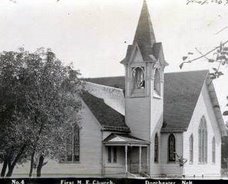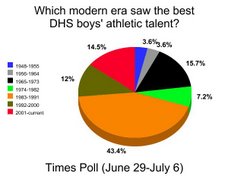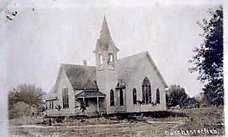
Can Dorchester avoid the population losses that now plague much of the Heartland?
In a recent nationally-syndicated column by economist Dr. Charles Wheelan, the author examines the human hemorrhaging occurring within the Plains' states. In many cases, these counties have lost more than 10 percent of their population in the past decade. (Click on the map to see a larger version.) Dr. Wheelan asserts there are three main causes for this trend:
- "Rising agricultural productivity means that we need fewer farmers to meet our food needs."
- "Highly skilled people are more productive when they're in close proximity to other highly skilled people."
- "Our existing farm subsidy programs don't help, and they probably make the situation worse."
We'll let our readers read the column for themselves and draw their own conclusions. But it's important to keep in mind there are two ways for a county to lose its population: People move away -- often called "outmigration" -- or there can be more deaths than births. In recent years, much of the Plains has seen population declines due to both factors.
 In the graphic to the left, USDA demographer Calvin Beale shows the parts of rural America that have lost population through both outmigration and a higher number of deaths than births. The counties that lost population because people left between 2000 and 2006 are colored tan. The counties that lost population because more people died than were born between 2000 and 2006 are purple. Those that lost population for both reasons are dark brown.
In the graphic to the left, USDA demographer Calvin Beale shows the parts of rural America that have lost population through both outmigration and a higher number of deaths than births. The counties that lost population because people left between 2000 and 2006 are colored tan. The counties that lost population because more people died than were born between 2000 and 2006 are purple. Those that lost population for both reasons are dark brown.
According to the USDA map, Saline County is one of only 14 Nebraska counties bucking the ugly trend.
USDA demographer Beale notes that this condition of Plains' population loss “did not did not arise overnight," and "poses difficult development challenges." Indeed. But so far, Dorchester is keeping its head above water -- thanks primarily to our close proximity to the large employment hubs of Lincoln, Crete and Seward.
As we have said previously, retaining our young people is important if Dorchester is to remain a viable community in the future.
In the past two or three decades, Dorchester has done a poor job in keeping its young people. We have failed to talk to our children at a young age and let them know that they are wanted and needed in their hometown.
When young people move away and never return, fewer new homes are built. Fewer children are born to sustain the local economy and educational services. Historic connections and family ties are lost forever. The community begins its slow death.
We urge our school administrators, teachers, town leaders and other residents to focus on Dorchester's future. We can and should take steps now by communicating openly with our young people about the population and economic challenges facing Dorchester.

 In the graphic to the left, USDA demographer Calvin Beale shows the parts of rural America that have lost population through both outmigration and a higher number of deaths than births. The counties that lost population because people left between 2000 and 2006 are colored tan. The counties that lost population because more people died than were born between 2000 and 2006 are purple. Those that lost population for both reasons are dark brown.
In the graphic to the left, USDA demographer Calvin Beale shows the parts of rural America that have lost population through both outmigration and a higher number of deaths than births. The counties that lost population because people left between 2000 and 2006 are colored tan. The counties that lost population because more people died than were born between 2000 and 2006 are purple. Those that lost population for both reasons are dark brown.

















































Once again, the Dorchester Times has read what’s left of my mind. I was watching an interview last night on C-Span about a new documentary entitled “King Corn.” (http://www.pbs.org/independentlens/kingcorn) The filmmakers attributed the population decrease mainly to the current farm subsidy program. All of us “prairie kids” know that the program originated with the Great Depression. Hoover’s program fixed price floors for wheat and cotton only while Roosevelt’s program dealt with the problem of oversupply by paying farmers not to produce. In addition, Roosevelt’s soil conservation program allowed the government to pay farmers to reduce production to conserve soil and prevent erosion. However, I had forgotten that Earl Butz, former Agriculture Secretary during the Nixon administration, radically altered the subsidy program. He urged farmers to plant commodity crops like corn and to "get big or get out." According to the U.S. Census, the Hispanic population in Saline County increased from 0.6% in 1990 to 6.6% in 2000. Is this why Saline County is one of only 14 Nebraska counties bucking the ugly trend?
ReplyDeleteCynical Richard:
ReplyDeleteYour comment has been removed due to content concerns. Try again.
The question above has been answered in the story ... our close proximity to the large employment hubs of Lincoln, Crete and Seward. I hate to break it to you all but the only way Dorchester gets bigger is if lincoln grows west.
ReplyDeleteI said that Dorchester had 614 in 1990 ............ now we have 615 ....... I don't see any need to add more people to Dorchester ......... Crete has grown ......... Do you like what you see there?............
ReplyDeleteMy conclusion would be that one of those employment hubs is Farmland meat packing plant and therefore the Hispanic population in Saline County has increased.
ReplyDeleteI hate to do this, but I agree with Cynical Richard. As for the comments above, I doubt that person lives here in Saline County. Hispanic population has increased at Farmland (I'd guess about 75% of the workforce there). However, the hispanics have replaced the vietnamese and low-skilled white population. The latter is still around these parts, only now instead of working for reasonable wages they collect welfare.
ReplyDeleteYou folks who are angry at the immigration mess need to blame the politicians who hand out welfare benefits as if they were candy - not employers looking for workers to produce a product. That's my 2 cents.
Amen!
ReplyDelete"In the past two or three decades, Dorchester has done a poor job in keeping its young people. We have failed to talk to our children at a young age and let them know that they are wanted and needed in their hometown."
ReplyDeleteAs nice as it is to say that to your kids, economic realities are economic realities. I make over twice the money doing what I do in Chicago rather than Nebraska...even with the cost of living increase in the Windy City I'm still coming out ahead. Plus there are far more opportunities for advancement. There is nothing wrong if you want to stay near your family or you are fine doing the same thing all your life and I don't want to take anything away from that. But people have different wants and needs, and when you are trying to pay off large student loans you have to go where the money is, and that certainly isn't in rural Nebraska.
Lindsay -- I lived in a metro area larger than the Chicago metro area for more than five years. I grossed more than $83,000 a year. I moved back to Nebraska a few years ago, and took a $15,000 pay cut to do so. On average, I can save about $650 more each month in Nebraska due to lower cost of living expenses, and I don't have to have a roommate as I did while renting in the big city. If I lived in Dorchester, I could probably save a little more and own my own house even with the extra costs of commuting. Of course larger cities offer more entertainment options and more career options. That's undeniable. However, if you can get a good paying job in Lincoln or Seward or Crete, you can be more financially sound than trying to run the rat race in the Windy City.
ReplyDelete-Former Big City Boy